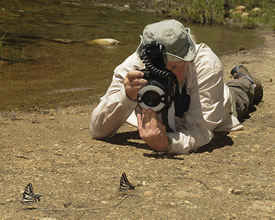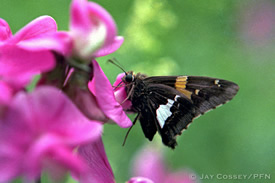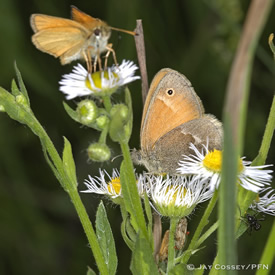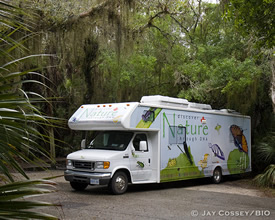Consider yourself personally invited to browse through these Photographs from Nature!
Welcome to Photographs From Nature! This website celebrates Nature through the images of Professional Nature Photographer, Jay Cossey.
The name, “Photographs From Nature” was inspired by photography in its infancy, long before cameras were designed to be used to capture nature. A time when nature photographs were just beginning to appear in print.
In the early 1900s, when a nature-related photograph was taken outdoors, it might be credited as: Photograph From Nature or Photograph from Life, followed by the photographers name.
I could not think of a more appropriate description of my work than Photographs From Nature.
Jay’s Biography
I was so fortunate to have been born into a nature-loving family. My father, Eric K. Cossey, was a draftsman by profession, but he had collected and reared butterflies and moths since he was a teenager. There were always caterpillars, chrysalises and cocoons in our house, so the miracle of metamorphosis was always on display in the Cossey household.
Dad had collected some great field guides and nature-related books, which I devoured as a child. I fantasized about some day seeing as many kinds of insect as possible. My favourite dreams always involved finding some butterflies I’d only ever seen in a book before. I was so disappointed to discover I’d only been dreaming when I awoke.
Nature publications with great photographs of live butterflies and other insects truly inspired me. I enjoyed collecting butterflies and moths, but I often dreamed of taking pictures of these ephemeral creatures. While my father took great care setting and preserving the specimens he kept, no dead specimen could fully capture the grace and fleeting beauty that expired once their lives were extinguished. Butterflies look great in a collection, but they’re far more beautiful in life.
When I was a teen, my Dad bought an inexpensive SLR camera. I was soon hooked. He let me take it into the field one day, equipped with the standard 50mm lens and some $15 close-up filters. My first photographs were not all wonderful, but one did stand out. It was so hard to wait for the local department store to process and print that first roll of film. I’ll never forget the joy of opening that envelope from the photofinishing lab and seeing this picture I’d taken of a Silver-spotted Skipper nectaring on Sweet Pea. From that moment on, I knew what I wanted to do for the rest of my life!
After graduating from high school, I took a job working in a large retail store warehouse. I still didn’t know what kind of career I would pursue—I only knew I wasn’t going to be satisfied working in a warehouse. I saved just enough money to purchase my own camera and a plane ticket to Australia. My best friend was an Australian who, with his Mom, was flying back to visit his aging Grandmother for a few weeks, so I asked to tag along. I borrowed my father’s close-up filters in case I saw any cool bugs.
The pictures I took on that vacation inspired me to further my education, in some field related to photography. I didn’t want to become a portrait or newspaper photographer, so I chose a more general course called “Audio Visual Technician”. This suited me, because it covered a wide variety of media, including Photography, Videography, Media Production, and Graphic Design.
I did well at college, earning my Audio Visual Technician certificate. While I applied for several positions as such, I actually landed a job as a Photographer at a local Studio called “Images”.
Twenty years into my career at Images, the photography industry had radically changed. Computers and the Internet began to undermine the professional photography business—but the computer revolution also brought about opportunity. Graphic Design, something I’d always dabbled in, was now done on a computer. As Images began to evolve into a Graphic Design business, I grew along with it. Before long, I was doing much more Design than Photography.
After a decade as Graphic Designer, and 30 years at Images, I was ready for a change. I spoke to a friend—a professor at the University of Guelph—about using my unique skill set in a Nature-related field. He put me in touch with a colleague, Dr. Paul Hebert, the recognized “father” of DNA Barcoding. Paul liked my work, and after “passing the audition” on a field trip to Churchill, Manitoba, he promised to create a contract position specifically tailored to my skills.
People Deserve to Know the Rich Diversity of Life on Earth
We are surrounded by unspeakable beauty, and yet, we become so driven to achieve a college degree, find a good job, support a family... We’re highly engaged with technology, social media, popular culture... Most of us seldom take time to stop, listen to the background sounds and appreciate the moon, the stars and all of Nature that surrounds us.
As long as humans have existed, we have lived in Nature. It’s only very recently that we’ve become “civilized”, urban creatures. It shouldn’t come as a surprise that Nature actually makes our spirit feel at peace. We enrich our lives by spending time in and around Nature. It’s our heritage. Our roots. Our home.
Perhaps part of the anxiety we all experience in life is due to this un-natural separation from Nature?
No one person can fully comprehend all of Nature—or even one facet of Nature. There so many different species on Planet Earth. We could devote our entire lives to try to know them, but the human mind can only process so much information.
The whole of Science doesn’t even know how many species there are on our planet, let alone have names for everything. There are hundreds of newly discovered species just waiting for someone to officially describe and name them. There may be thousands that will become extinct before we even know they existed here for countless generations.
Why Nature Photography is Important to Me
It’s a privilege to document and preserve fleeting moments in time, hoping to inspire and educate others about the beauty and complexity of Nature. But it’s also a personal journey for me.
I have witnessed and learned so much about this world while taking these pictures. I’ve been blessed by the tutelage of my father, and countless others since.
When my Father was in his declining years, I was so thankful for the gift of photography. When he was no longer capable of hiking the paths, wading through streams and navigating hills and dales, I was able to bring Nature to him with my camera. I’m sure there are many others with similar physical limitations, so I’m delighted to bring Nature’s beauty to everyone via this website.
Documenting the behaviour and interactions within the backdrop of the subject’s natural habitat is a priority in all of my work. Every picture should tell a story—a true story about each subject’s behaviour and interactions.
Natural History can be even more interesting than the physical attributes of the creatures themselves. Many butterflies are exquisitely beautiful, but if you remove them from their environment and, for example, photograph them in a studio on a seamless white background, you lose so much information about these creatures and the world in which they live.
I virtually never pose a stunned or immobilized subject on a pretty flower for decorative purposes. I want to show Nature as you would see it had you been there to witness it in person.
I’ve taken staged photos of butterflies in the past, but I always felt empty afterwards, as if I’ve cheated somehow. That’s not meant to judge others who do manipulate their subjects; it’s simply unsatisfying to me. I find it much more rewarding to capture moments of reality—with all the intrinsic limitations and surprises, than it is to impose my own creative vision on any particular subject. For example: most butterflies would never alight on a garden variety rose bush. It might make for a colourful picture, but I find it much more gratifying to show them nectar at a flower of their own choosing.
I think of myself as a Nature Photojournalist rather than an Artist. Nature is the Artist—I’m an interested observer who is attempting to document Nature. It would be wrong for me to take credit for Nature’s beauty and drama. The ultimate Artist in my work is the Creator of Nature. I leave it to the viewer to decide who that might be. I will take credit for this: there is a high degree of craftsmanship involved in composing and creating a good photograph, so thank you to those who appreciate my efforts and encourage me to continue.
I approach Nature as any honest photojournalist would document a newsworthy event. There are so many stories to be told in Nature as it unfolds before those who are willing to get out there and simply observe.
My Dream Job
I landed at the Biodiversity Institute of Ontario (“BIO” at the University of Guelph) in February of 2008. My first task was to dip into my photo archive and employ my abilities as a Graphic Designer to create full-wrap graphics for what later became known as “BIObus”. I was also charged with preparing the 30-foot RV for use as a mobile field lab.
Over the next 4 years, I led BIObus and crew to over 20 National Parks in Canada, and numerous State Parks from Florida to California in the southern US.
BIObus consisted of me and a rotating crew of grad students and researchers which changed for each expedition. Paul Hebert deployed BIObus to various regions to collect insect and other invertebrate specimens for DNA Barcoding back at the University. It was my responsibility to take care of the logistics and manage whatever crew he selected to maximise the efficient operations of BIObus.
Typically, we would embed ourselves in a park, equipped with the appropriate permits, of course, and spend from several days to one week surveying the invertebrates of that location. We were frequently called upon to do educational talks, both for park staff and park visitors. We would deploy all manner of passive traps (pitfalls, malaise, pans, etc.), then hand sample with insect nets, UV lights, etc.
After four very enjoyable and highly successful years at BIO, a funding shortfall resulted in my contract not being renewed. I’ve been doing freelance work since that time.
Inspiration
I often think of that line from the movie, “Chariots of Fire”: “I believe God made me for a purpose, but he also made me fast. And when I run, I feel His pleasure.”
The truth is, as hard as I might try, photographing Nature is an inexplicable passion. I’m absolutely driven to do this. It gives me a great sense of satisfaction—and, to some extent, “I can feel His pleasure” when I do what seems to be the very thing I was born to do. It’s only natural!
This has always been the case. For many years I’d simply label, sort and file my Kodachromes away, not knowing anyone would see them but me. The Internet eventually provided a way to share these images with others.
In his book, “Reflection on St. Francis”, author John Michael Talbot shares the following anecdote when St. Francis of Assisi looked up and noticed the moon.
“Overcome by the sheer beauty of the moment, and wanting to share it with the world, (St. Francis) stole into the town’s church, ascended its bell tower, and began furiously ringing the bells. “Lift up your eyes, my friends,” he cried out to his curious and angry neighbors. “Lift up your eyes. Look at the moon!”
PhotographsFromNature.com has become my way of ringing those bells in the tower. Drawing attention to the wonder of Nature, my sincerest hope is that you will join me, awestruck as wide-eyed children. If you’re not doing this already, I hope my photographs will inspire you to invest the time to pay closer attention to the natural world all around us, and in turn, encourage others to appreciate the beauty of Nature.



